|
|
|
Integration Statue
by Tara L. Benton
This
monument stands as a “celebration of hardships and successes of a group
of
young men and women with a vision” to make FSU a center of learning for
all
people.
Though the doctrine of “separate
but equal” in public education was overturned in 1954, integration in
post-secondary institutions in Florida
did not immediately follow. In 1962, without the
prompting of litigation, FSU changed its policy
and admitted African
American students. Twelve
African American science teachers enrolled in graduate science courses
at Florida State University
in the summer of 1962, becoming the first African American students at
the
university. In the fall, FSU enrolled its first
three full time African American students, two graduate students and
one
undergraduate. The undergraduate
student, Maxwell Courtney, became the first African American graduate
of FSU in
1965. Also in 1965, Fred Flowers
enrolled in FSU. He became the first
African American to wear an FSU athletic uniform. In 1970, FSU
students elected the first
African American Homecoming Queen, Doby Lee Flowers.
In 2002,
former Florida State
University President Talbot D’Alemberte commissioned a monument to
celebrate the
efforts of students at FSU who pioneered integration in the
1960’s. The funds for the monument were raised from
private donations. The bronze sculpture,
which cost $350,000, was created by sculptor W. Stanley Proctor in
2003. Proctor, a native Floridian, began sculpting
in the 1980’s. He is now a prize-winning
and renowned sculptor, with works on display at the Florida Governor’s
Mansion.
|
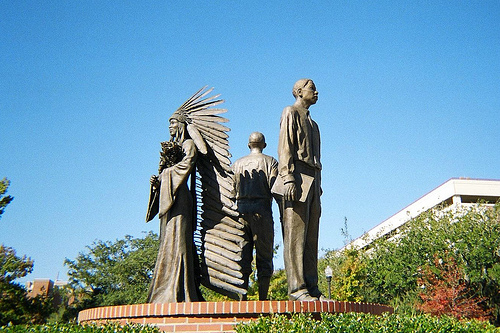
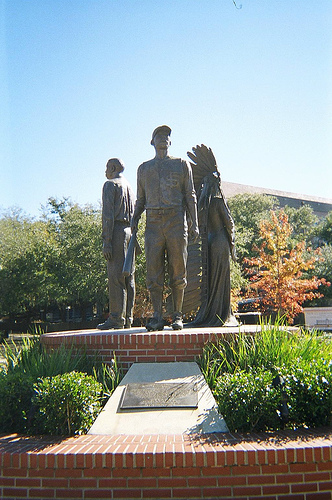 |
The monument, titled
“Integration,” was unveiled during the Heritage Day Celebration on
January 30,
2004. The monument consists of three
figures standing approximately nine feet tall on a circular brick
pedestal, and
is based on the concept of “books, bats, and beauty.” The first
African American students at FSU
faced a multitude of challenges in the efforts of integration of the
university. The students worked for
integration in all aspects of campus life, including academic,
athletic, and
social. The planners of the monument,
including D’Alemberte, Doby Flowers, Proctor, and FSU officials,
decided that
the “books” element of the monument theme was best represented by
Courtney, the
first African American graduate; the “bats” element was best
represented by
Fred Flowers, the first African American athlete; and the “beauty”
element was
best represented by Doby Flowers, for the significant social
achievement of
becoming the first African American Homecoming Queen.
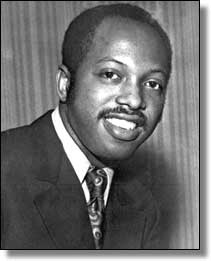
|
Maxwell
Courtney graduated Tallahassee’s Lincoln High
in 1962. He attended FSU from 1962 through 1965, when he earned his
B.A. He is depicted in the monument holding an
American History Book. After FSU, he
went on to consult for the Smithsonian Institution before his death in
1975.
Fred H. Flowers entered FSU in
1965. He earned his B.A. in 1969 and his
M.S. in 1975. He is depicted in the
monument in his baseball uniform. At his
speech during the unveiling celebration, Flowers stated, “Florida State
University stands alone
as a shining light, as a beacon of diversity and multiculturalism.
This is what the statues represent.” Flowers is a
Tallahassee native,
and has been a member of
The Florida Bar since 1981. He has a law
practice in Tallahassee. |
| Doby
Lee Flowers attended FSU from 1967 through 1973, earning her B.S. and
M.S. degrees. Flowers
was crowned Homecoming Queen in November 1970.
In the 1970-1971 Tally Ho Yearbook, she was quoted as saying, “In
December, one month after I was elected, an official with the gifts
from
merchants finally got in touch with me.
She said she had been delayed because she couldn’t find out where I
lived. Not being awarded the homecoming
trophy … not being asked to attend out of town football games, not
being
invited to participate in the gubernatorial inaugural parade – that’s
what it’s
like to be a black queen at FSU.” At the
unveiling of the Integration Statue in 2004, Ms. Flowers stated, “It is
very
rare that one gets to make a contribution on behalf of so many that
will always
be recalled in the annals of history. And, it is even rarer that the
actions of
young idealists are memorialized through such a public work of art that
is so
grand and powerful.” Doby Flowers,
Fred’s sister, is also a native Tallahasseean.
She has a career in law practice management and consulting. |
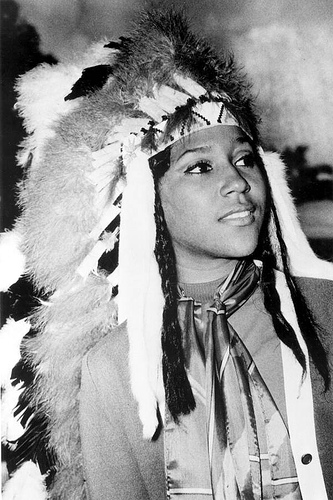
|
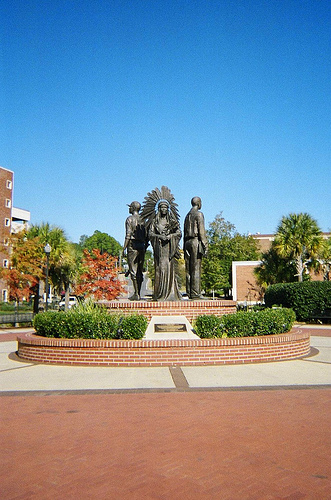
|
These
three individuals are
representative of the many brave young idealists who fought for
equality in
education and in all aspects of life during the turbulent 1960’s.
The
Integration monument is placed in Woodward Plaza, near Oglesby Union
and at the end
of the paved portion of Woodward at the main entrance to the
University. This prominent placement ensures that the
students of today and the future are reminded of the journey their
fellow FSU
alumni undertook in demanding social, academic, and athletic equality,
and
should stand as a reminder of the importance of continuing in those
efforts to
indeed make FSU a center of learning for all people.
The unveiling of the monument did
stir controversy among some Native Americans.
The FSU Homecoming Queen was adorned with a non-Seminole style
Native-American headdress through the 1970’s.
Though the university no longer uses this headdress for the Homecoming
Court,
Doby Flowers was depicted as such in the sculpture. Though the
university consulted with the
Seminole Tribe of Florida regarding the use of this headdress in the
monument,
other Seminole tribes objected.
President D’Alemberte stated that the figures were created as
historically accurate representations of moments in time. |
| Photographs
of Statue by Tara L. Benton |
|
|

